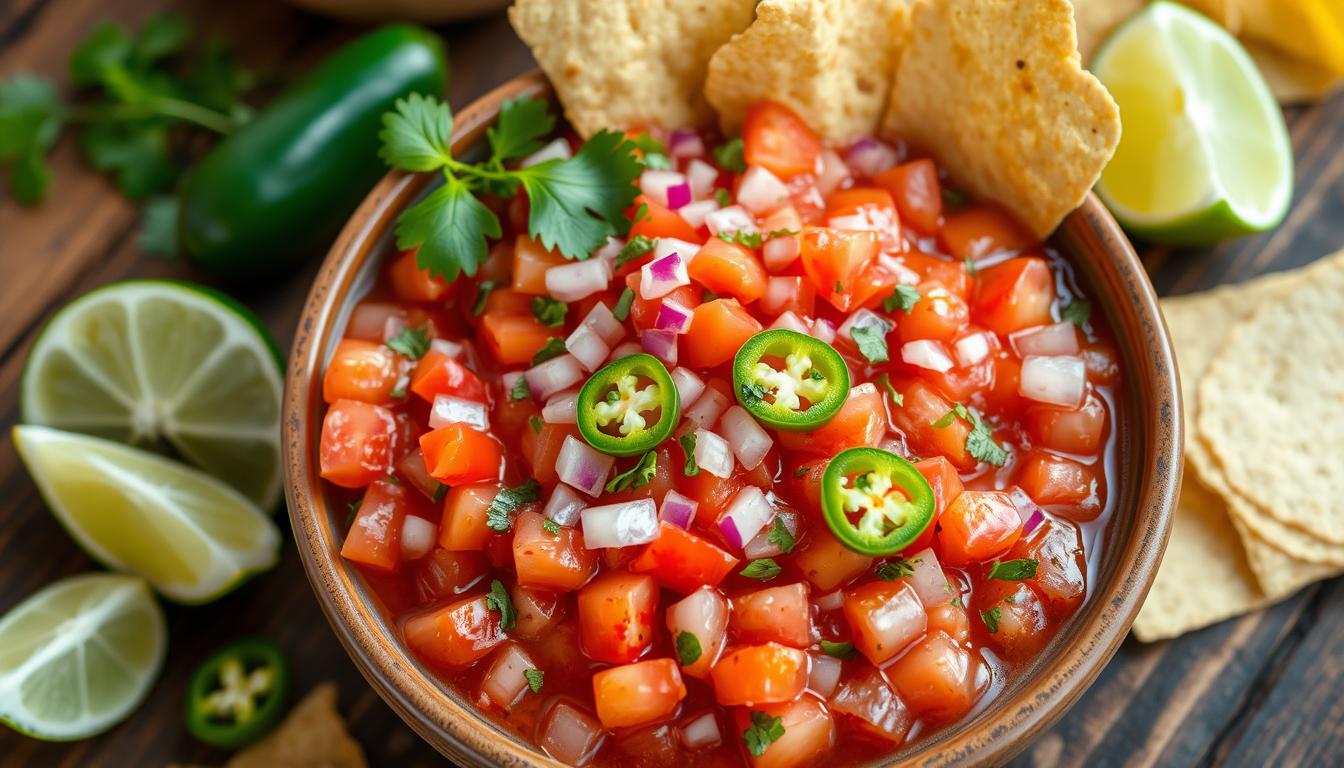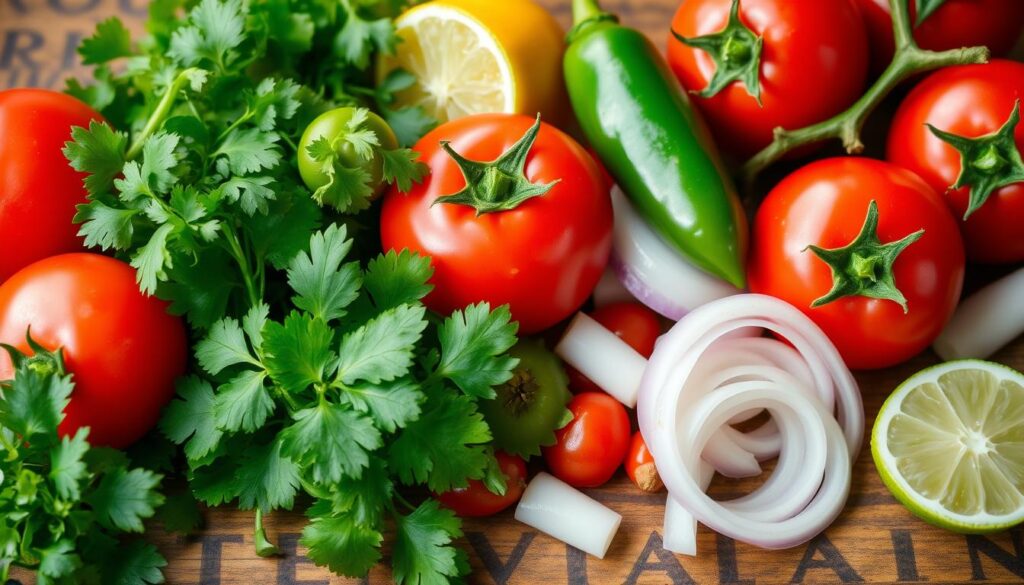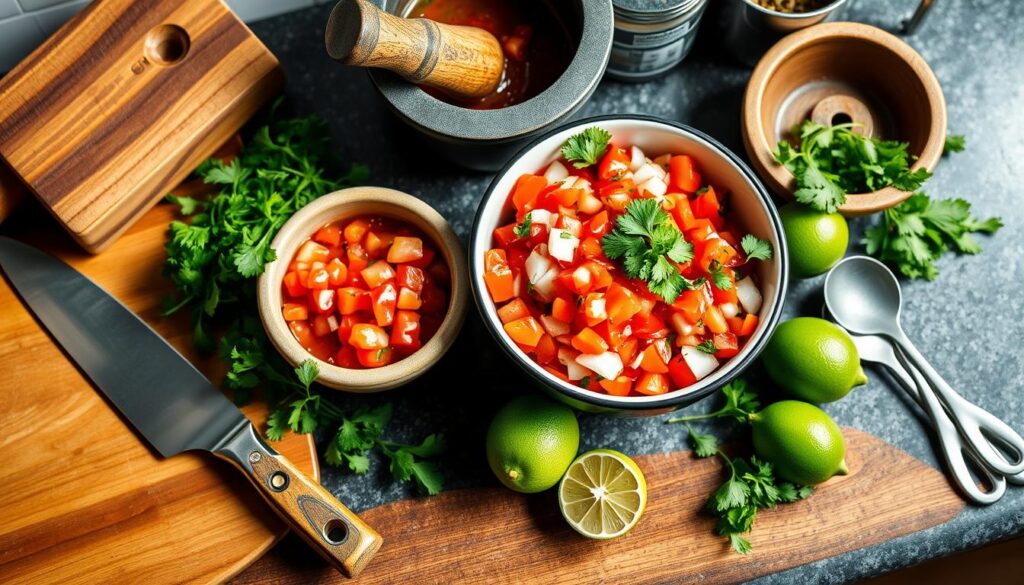Growing up in a Mexican-American home, the smell of fresh salsa was always there. It filled my childhood with warmth and lively tastes. The sizzle of jalapeños, the tang of lime, and cilantro’s scent were our family’s cooking traditions.
As I got older, I learned to love making the perfect spicy salsa. It’s a skill that brings me pride and happiness in my kitchen.
Key Takeaways
- Discover the secrets to creating authentic, homemade spicy salsa using a blend of fresh and canned ingredients.
- Learn how to balance the heat, acidity, and sweetness to achieve the perfect flavor profile.
- Explore the versatility of spicy salsa in a variety of dishes, from appetizers to main courses.
- Understand the proper storage techniques to ensure your homemade salsa stays fresh and flavorful.
- Gain the confidence to experiment with different pepper varieties and unique flavor combinations.
Understanding Spicy Salsa: What Makes it Unique?
Salsa is a key part of Mexican food, loved across Latin America and more. It’s made with fresh, tasty ingredients that give it a special taste. Tomatoes, garlic, and onions are just a few things that make spicy salsa so unique.
Key Ingredients of Spicy Salsa
Traditional salsas mix tomatoes, onions, chilies, and herbs for a flavor explosion. Pico de Gallo, for example, has diced tomatoes, onions, cilantro, jalapeños, lime juice, and salt. Salsa Verde uses tomatillos, green chili peppers, onions, and cilantro. Salsa Roja blends cooked tomatoes, chili peppers, garlic, and onions.
The Role of Heat in Salsa Flavor
Chili peppers make spicy salsa hot. Jalapeños are mild, while serranos are a bit hotter. Habaneros add a fiery kick with a fruity taste, making the flavors more interesting.
Different Types of Spicy Salsa
There’s more to spicy salsas than the usual. Fruit salsas, like those with mango or pineapple, are sweet and tangy. Spicy avocado salsa combines ripe avocados with jalapeño peppers, cilantro, lime, and onions. Roasted corn salsa adds a smoky sweetness, great for summer.
“Salsa-making emphasizes freshness, balance of flavors, and texture experimentation.”
Essential Tools for Making Salsa
Making the perfect spicy salsa at home needs more than just fresh ingredients. You’ll need the right kitchen tools to get the texture and flavor just right. Let’s look at the essential tools to make your homemade salsa shine.
Must-Have Utensils
Start with a sharp chef’s knife or santoku knife for chopping and dicing. You’ll also need a sturdy cutting board, like wood or bamboo, for a stable surface.
A liquid measuring cup and set of measuring spoons are key for portioning out ingredients. This ensures your salsa has the right balance of flavors. And, a large mixing bowl is crucial for combining and mixing the salsa to your liking.
Optional Appliances to Consider
While not essential, some kitchen appliances can make salsa-making easier. A food processor or blender can quickly chop, blend, or purée your ingredients. This is great for a smooth salsa.
For extra flavor, think about a citrus juicer or garlic press. These tools help get the most juice from citrus fruits and mince garlic easily. They add depth and complexity to your salsa.
| Essential Utensils | Optional Appliances |
|---|---|
|
|
With the right tools, you’re ready to make the perfect homemade spicy salsa. It will be full of vibrant flavors and the perfect mix of heat and freshness.
Choosing the Right Peppers for Your Salsa
Choosing the right peppers is key to making the perfect spicy salsa. You can pick from jalapeños to fiery habaneros. Each pepper brings its own flavor and heat level. This lets you create a salsa that matches your taste.
Popular Pepper Varieties
Here are some common peppers for salsa:
- Jalapeños: These peppers offer a moderate heat, with 2,500 to 5,000 Scoville heat units (SHU).
- Serranos: Known for their bright flavor and a bit more heat, serranos range from 10,000 to 23,000 SHU.
- Habaneros: Habaneros are bold, with a heat of 100,000 to 350,000 SHU.
- Chipotle peppers: Smoked jalapeños, chipotles add a smoky depth to salsa, with a heat of 2,500 to 8,000 SHU.
Heat Levels: A Guide to Scoville Units
The Scoville scale measures a pepper’s heat. It ranges from 0 for sweet bell peppers to over 2 million SHU for the hottest peppers. Knowing this scale helps you balance flavor and spice in your salsa.
| Pepper Variety | Scoville Heat Units (SHU) |
|---|---|
| Bell Peppers | 0 SHU |
| Poblano Peppers | 1,000 – 2,000 SHU |
| Jalapeños | 2,500 – 5,000 SHU |
| Chipotle Peppers | 2,500 – 8,000 SHU |
| Serrano Peppers | 10,000 – 23,000 SHU |
| Cayenne Peppers | 30,000 – 50,000 SHU |
| Habanero Peppers | 100,000 – 350,000 SHU |
| Carolina Reaper | 1,500,000 – 2,200,000 SHU |
| Pepper X | 2,693,000 SHU |
Balancing Flavor and Spiciness
When picking peppers, think about the heat level you want. For a milder salsa, mix jalapeños and serranos. For a spicy kick, try habaneros or chipotle peppers. Experiment with different peppers to find the perfect mix of flavor and spice for you.
Fresh vs. Canned Ingredients: Pros and Cons
Choosing between fresh or canned ingredients for homemade spicy salsa is a common debate. Each option has its own benefits. Knowing when to use each can help you achieve the best taste and texture.
Benefits of Fresh Ingredients
Fresh tomatoes, onions, and herbs like cilantro give your salsa a lively taste. The sweetness and acidity of ripe San Marzano tomatoes make a big difference. Fresh ingredients also keep more of their nutrients than canned ones.
When to Use Canned Alternatives
Even though fresh is usually better, canned San Marzano tomatoes have their perks. They offer a consistent flavor and are convenient. Canned ingredients are great when fresh produce is hard to find or out of season.
Choosing between fresh and canned ingredients depends on your taste, what’s available, and your recipe. Mixing both can create the most delicious salsa.
“Roasting salsa over charcoal enhances its flavor by adding depth and smokiness to the ingredients.”
– Chef Antonio Nuño
Step-by-Step Recipe for Spicy Salsa
Making the perfect homemade salsa is like an art. It lets you play with bold flavors and textures. Whether you like a little kick or a lot of heat, this guide will help you make a spicy salsa that will wow you.
Preparation Techniques for Fresh Ingredients
First, heat your oven to 400°F (205°C). Roast tomatoes, onions, and peppers for 25 to 30 minutes. They should be soft and slightly charred. Let them cool down before you touch them.
While the veggies roast, toast cumin seeds in a skillet for 1-2 minutes. This brings out their aroma. Let the cumin seeds cool down.
Mixing and Texturing Your Salsa
In a blender or food processor, mix the roasted veggies, cumin seeds, cilantro, lime juice, and a bit of salt. Blend until it’s the texture you like. You can have it chunky or smooth.
Adjusting Spice Levels to Taste
Try your salsa and adjust the flavor if needed. For more heat, mix mild jalapeños with hot habaneros. Be careful with habaneros; wear gloves to avoid skin irritation. The goal is to find the spice level that you enjoy the most.
With these easy steps, you can make a spicy salsa that will make your Mexican dishes better. Enjoy it with tortilla chips, tacos, or as a topping for many dishes.
Flavor Enhancements: Adding More Depth
Make your homemade spicy salsa even better by trying out herbs and spices. Cilantro brings a fresh, bright taste that makes your salsa pop. Cumin adds a warm, earthy flavor, and oregano brings a herbal twist. Experiment with these to find your favorite taste.
Acidity is key in balancing your salsa’s flavors. A squeeze of lime juice or a bit of vinegar can cut through the richness. It adds a refreshing zing. Adjust the acidity to your liking, as it greatly affects the taste.
Want to add more depth to your spicy salsa? Try chipotle peppers in adobo sauce or roasted green chiles. These ingredients bring smoky, complex flavors that make your salsa stand out. Let your creativity guide you.
| Ingredient | Impact on Salsa Flavor |
|---|---|
| Cilantro | Bright, fresh herb flavor |
| Cumin | Earthy, warm spice character |
| Oregano | Herbal, slightly peppery notes |
| Lime Juice | Balances richness, adds refreshing acidity |
| Chipotle Peppers in Adobo | Smoky, complex spicy heat |
| Roasted Green Chiles | Earthy, slightly sweet, moderate heat |
“The key to a truly memorable salsa is finding the perfect balance of flavors, from the bright acidity of lime juice to the warm, earthy notes of spices like cumin and oregano.”
Storage and Shelf Life of Homemade Salsa
Keeping your homemade salsa fresh and flavorful is key. Whether it’s for game day or a fiesta, knowing how to store it is important. This way, you can enjoy every bite.
Best Practices for Storing Salsa
Use airtight containers or mason jars to store your salsa in the fridge. This stops the ingredients from losing their taste. Make sure to leave some space in glass containers for expansion. Adding a thin layer of olive oil on top can also help.
How Long Does Spicy Salsa Last?
Homemade salsa lasts 5-7 days in the fridge. Jarred salsa can stay good for up to two weeks after opening. Freezing your salsa can extend its life to 2-6 months.
Signs of Spoilage to Watch For
Watch for signs of spoilage in your salsa. Look for color, texture, or smell changes. A sour smell, mold, or a watery texture are bad signs. If it’s been out for more than 4 hours, it’s best to throw it away.
By following these tips, your homemade salsa will stay fresh and safe. Enjoy it right away or over the next few days.
Pairing Your Spicy Salsa with Food
Homemade spicy salsa is a versatile condiment that can elevate a wide range of dishes. It’s perfect for classic Tex-Mex recipes and innovative culinary creations. Exploring the best ways to serve your zesty salsa can open up a world of flavorful possibilities.
Best Dishes to Serve with Salsa
The obvious choice for serving spicy salsa is with crisp tortilla chips. This allows you to fully enjoy the bold flavors and textures. Beyond the classic chip-and-salsa pairing, consider incorporating your homemade salsa into Mexican cuisine staples like tacos, burritos, enchiladas, and quesadillas.
For breakfast, try serving your spicy salsa with huevos rancheros. This traditional Mexican dish features fried eggs, refried beans, and warm tortillas. The combination of the savory, spicy salsa and the rich, runny egg yolks is simply irresistible.
Creative Uses Beyond Traditional Pairings
Don’t limit your salsa to just Mexican-inspired dishes. Explore innovative ways to utilize your homemade creation. Stir it into scrambled eggs or omelets for a flavor boost. Drizzle it over grilled meats, fish, or roasted vegetables for a zesty accent.
The versatility of spicy salsa allows you to experiment and discover new culinary combinations. Embrace the bold flavors and let your creativity shine as you pair your homemade salsa with a wide array of dishes, both traditional and unexpected.
Troubleshooting Common Salsa Issues
Making the perfect salsa at home is a fun journey. But, sometimes you might face a few problems. Don’t worry, we’ve got the answers to help you fix these issues and get the taste and texture you want.
How to Fix Overly Spicy Salsa
If your salsa is too hot, there are simple ways to fix it. Start by adding more diced tomatoes or fresh lime juice to balance the heat. You can also mix in some plain Greek yogurt or sour cream to cool it down.
If it’s still too spicy, try adding onions, garlic, or cilantro. These ingredients can help dilute the heat and improve the flavor.
Balancing Flavors When Something is Off
If your salsa tastes off, it’s time to make some adjustments. If it’s too acidic, a little sugar or honey can help. On the other hand, if it’s too sweet, a bit of vinegar or fresh lime juice can balance it out.
Remember, small changes can make a big difference. Keep experimenting until you find the perfect balance of flavors.
Tips for Achieving the Ideal Consistency
The texture of your salsa is just as important as its taste. If it’s too watery, try draining some liquid or adding more diced tomatoes or onions. This will help thicken it.
For a chunkier salsa, pulse the ingredients in a food processor. This way, you’ll get a coarser texture. If your salsa is too thick, a splash of water or lime juice can thin it out.



